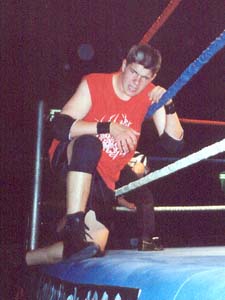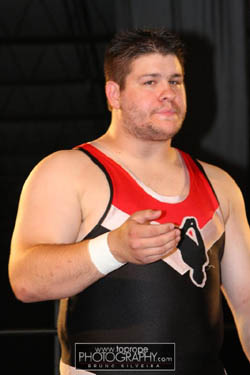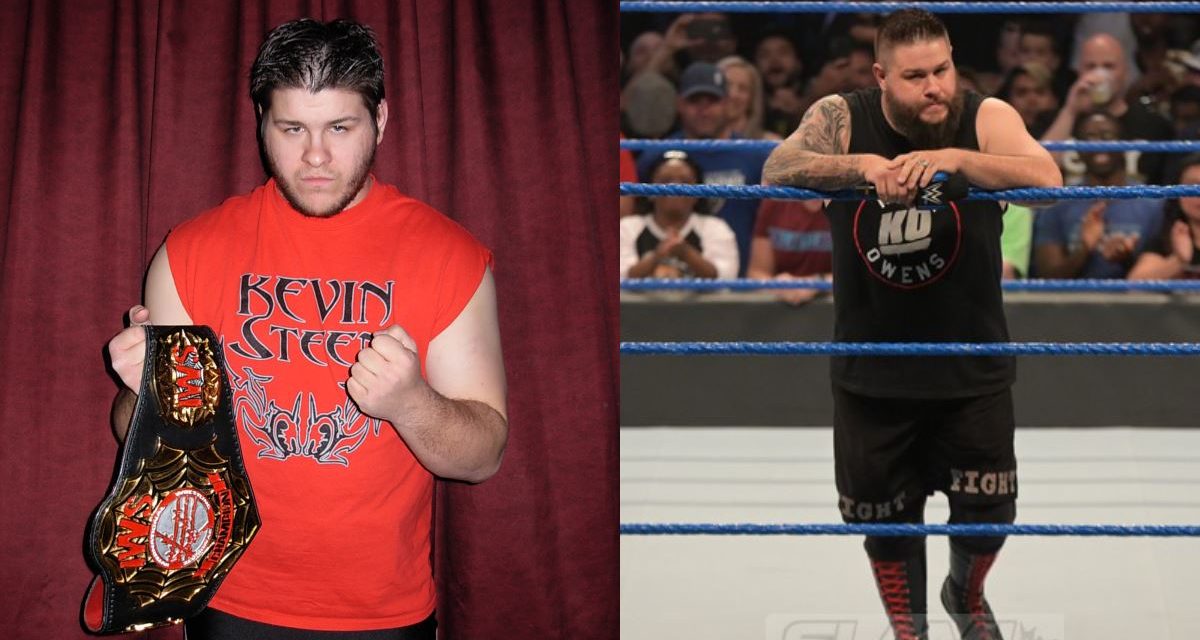Ring of Honor Wrestling makes its Canadian debut this Friday, as the company kicks off a huge weekend with an event at Toronto’s Ted Reeve Arena. Hoping to make the night even more memorable is Kevin Steen, who has the chance to become the first ROH World Championship to come from the Great White North.
Steen, who hails from Montreal, is confident that with the support of his fellow Canucks, he will be able to wrest the title away from champion Nigel McGuinness.
“It’s a bit nerve-wracking,” Steen admitted to SLAM! Wrestling. “I’m nervous for every title match, but this one even more. (On Friday, I’ll be) wrestling in front of my countrymen, and my family — my parents are driving in to see it, and my wife and son will be there — it adds a whole new dimension to it. I want to be the first Canadian Ring of Honor champion, and to be able to do that in front of a mostly Canadian crowd, that’s definitely a big deal for me.”
Steen, or “Mr. Wrestling” as he’s billed, has become a ‘big deal’ in his own right over the years. Winning the title would be an achievement of his childhood dream — a phrase that was famously used when Shawn Michaels won his first WWE championship; fitting, considering that it was watching Michaels that turned Steen on to wrestling in the first place.
“When I was 11 years old,” Steen recalled, “my dad rented a tape of Wrestlemania 11. It was after watching Shawn Michaels that I basically became a wrestling fan, and decided that I wanted to be a wrestler.”
Three years later, Steen started training.
“When I was 14, I trained in this school with some other Quebec wrestlers. The place was a barn that had a ring in it. After a month,” he chuckled, “the barn collapsed onto the ring, and they had to shut down the school. It took me a year to find another school, and that ended up being Jacques Rougeau’s school, which had just opened. I started training regularly there when I was 15.”
He wrestled his first match on his 16th birthday on May 7, 2000, and then spent the next few years wrestling exclusively for Rougeau. Though the shows were professionally promoted and well-run, Steen found himself growing frustrated at the pace of his career development under Rougeau.
“I really wanted to learn, and I didn’t think I was getting that experience. (Rougeau) was running shows only every three or four months — four shows a year, tops. They were pretty big — there would be about 2,000 or 3,000 people there. But he would spend to do advertising for them, newspaper ads, which is why he did them only every few months. And you were only allowed to wrestle for him. He didn’t want his wrestlers going anywhere else and working for any local promotions. I guess he felt that if he put your face in the newspapers to hype up his shows, that other promotions you might wrestle for would get the benefit from it.

Steen at a Rougeau show in June 2001.
“So, that meant I was wrestling the same guys over and over at the wrestling school. We would work on our match every week for three months and then have the match in front of a crowd. And then it would happen again until the next show, just with a different opponent. We were running out of wrestlers! Because of that, I felt I wasn’t learning as much as I could. So I decided to go out on my own.”
After leaving Rougeau’s promotion, Steen started wrestling with other companies in Montreal, in particular, the IWS. A year later, he was invited, along with his future tag team partner, the masked El Generico, to appear on a show for the Philadelphia-based Combat Zone Wrestling.
Though the match — a four-way with Steen, Generico, Sexxxy Eddie and Excess — was well-received by fans, it was a different story backstage.
“A lot of the wrestlers there didn’t like us,” Steen revealed. “You know how there’s a tradition in wrestling that when you go into the locker room, you shake everyone’s hand? In Quebec, that’s just not something that we do. So when we got to the building, we didn’t do that. We kind of stayed in our corner — we were nervous, it was our first American show and we didn’t want to step on anyone’s toes. We wanted just do our match and have the best match we could. We went out there and we stole the show, and I guess some of the wrestlers thought we did too much in our match. I figured we would never (get invited) back.”
So it was a pleasant experience when they were. Their next match, a tag team battle pitting he and Generico against Super Dragon and Excalibur, was one of the company’s best in 2005, and resulted in the pair getting regular bookings with CZW.
“We got a lot of exposure from CZW, and then started getting in with other companies, like Pro Wrestling Guerilla and IWA Mid-South and a lot of promotions in the States. So then we ended up having to take some CZW shows off. Again, that rubbed a lot of people the wrong way, so when we did ultimately did have the chance to go back, it was like starting all over again with the locker room. There was a lot of tension the entire time we were there.”
Despite his backstage problems, in the ring Steen continued to make a name for himself, winning the company’s Iron Man Championship in August 2005. However, Steen soon became disgruntled with the way he was being used in CZW.

Kevin Steen at an ROH show earlier this month in Hartford, CT. Photo by Bruno Silveira, TopRopePhotography.com
“I was Iron Man Champion for a full year, and I defended the belt only five times. Every month I’d get there, and they’d change things around. I would go there expecting to defend the title, and they’d put me in a three-way instead. There was five months where I never defended the title, which I thought was getting to be ridiculous. They’d make me do promos for their show, but they wouldn’t give me any guidelines as to what I should talk about, or what I’d be doing on the next show.
“So then I started expressing my anger about CZW, just to see if somebody would notice, but it seems that nobody did. Had somebody just come up to me and asked me why I was saying everything I was saying, I would have stopped or at least tried to work it out, but nobody ever did. Nobody ever told me to stop badmouthing the company. And I think maybe that was exactly what the problem was with CZW.”
The end of the relationship was not a particularly pleasant one, recalled Steen. “I told them I was going to be leaving the company for about three months, and when that time came, (owner) John Zandig made it seem like it was a complete surprise, and that really pissed him off. He said that was it, get out. It ended pretty abruptly and not on good terms.”
Soon thereafter, Steen’s journey took him to Japan, where he toured with the Dragon Gate promotion between October and December 2006. It was an incredible experience, said Steen, in particular learning the Japanese style of wrestling which he has been able to incorporate well along with his North American training.
While Steen was in Japan, his partner Generico was looking to rekindle a relationship with Ring of Honor. The duo had had worked some limited dates with ROH in 2004, but nothing long-term came out of it at that time.
“We just didn’t click with the fans back then,” offered Steen as an explanation. “I know that I’m a very different wrestler now than I was back then. Back then, I wasn’t really showing them who I was in terms of my character, my personality. We were going out there with the only thought being to try and have the best match you can — especially in Ring of Honor where the fans are so knowledgeable. So I went out there and tried to put on some classic matches. But I didn’t portray my own character — it just wasn’t me out there in the ring, and I guess they could see that.”
This time, Generico struck a chord with the fans and the company decided to call Steen to join him, which he did in February 2007.
“They put me and Generico together to team against the Briscoe Brothers for one night. We ended up tearing the house down, and they offered me a full-time spot.”
The feud between Steenerico, as fans dubbed the team, and the Briscoe Brothers was one of wrestling’s best in 2007, culminating in a brilliant ladder match, the first ever in Ring of Honor, at the Man Up pay-per-view show in November. This was heralded as one of the best matches of the year by many wrestling pundits.
“When that match ended,” Steen remembered, “I knew we’d had a crazy match and that the crowd loved it. When I finally was able to watch it on pay-per-view, I think, as much attention as the match got, I think it would have gotten even more if they hadn’t debuted the Age of the Fall right afterwards. I think that promo took away a bit of the climax from the ladder match. But overall, that was one of the proudest moments of my career. I remember after the match ended, Jay grabbed the belt, and I fell down from sheer exhaustion. The crowed was chanting ‘Match of the year!’ Even though I was disappointed we didn’t get the tag straps, that feeling was a reward in and of itself.”
On Friday, Steen is hoping to leave Toronto with a more tangible reward in hand — namely, the ROH World Championship.
“There’s nothing bigger than that,” he affirmed. “Even though my priority this last year was to win the tag titles — and I still do want to do that — my goal right now is to walk out of Toronto with the belt and then defend it on Saturday in Detroit against Claudio Castagnoli.”
The Saturday show, which will be held at the Michigan State Fairgrounds, will be a pay-per-view taping. As with previous ROH shows in Detroit, a large Canadian contingent of fans is expected to attend that one as well. Depending on how well the show goes on Friday — and indications are that it will be very successful, based on advance ticket sales — it’s possible that the Toronto-Detroit loop will become a regular stop for ROH.
“Every new city, not to mention a new country, is really important to build a bigger market,” Steen said. “Look at how much the company has grown in the past few years, from starting as a local company, and now going to Japan and England, and now into Canada. If we can keep growing, keep getting regular towns and new territories, that’s how we will continue to succeed, to keep getting better.”
The formula to doing so is fairly simple according to Steen: it’s to keep presenting an alternative product from WWE and TNA that simply focuses on presenting the best wrestling product out there.”
“I watch WWE and sometimes TNA,” Steen said. “One of the complaints I have, and what I’ve heard a lot of fans say is ‘What’s with all the talking? Why is the match only two minutes long?’ Well, a huge part of the appeal of a Ring of Honor show is that you don’t get a lot of talking. Ring of Honor is wrestling. It’s wrestling at its best. In Toronto and in Detroit, fans will get to see that.”
TED REEVE and his ARENA
The Ted Reeve Arena may not be Maple Leaf Gardens in Toronto wrestling (or hockey) history, but that doesn’t mean it wasn’t a non-factor.
Professional wrestling was held off and on over the years in the east end arena, which was built in 1954. It is named after Ted “The Moaner” Reeve, one of the most influential men in Toronto sports history. Reeve grew up in East York, and lived in the Beach for many years. He was a football hall of famer, a lacrosse star, and served as a coach for many years. He later became a sportswriter for the Toronto Telegram and then the Toronto Sun. He died in 1983 at the age of 81.
RELATED LINK

